Stephanie Wu creates sparkly neon gif collages that animate your phone in a dizzying barrage of creepy white stock image smiles, dolphin emojis and chat text bubbles. But beneath their aggressively cheery palettes, both Wu’s recent collages and their installation works explore the challenges queer people of colour face when navigating whitewashed spaces that claim to be inclusive. Lizzy Hill caught up with Wu, a first generation Chinese-Canadian artist and educator, following their installation of We Met Online: Finding Each Other at the Khyber Centre For the Arts and on their way to presenting Not Your Model Minority, a gif projection at Toronto’s first Asian Zine Fair. Hill and Wu chat online about everything ranging from Wu’s approach to self-care to their unique spin on the ubiquitous gif.
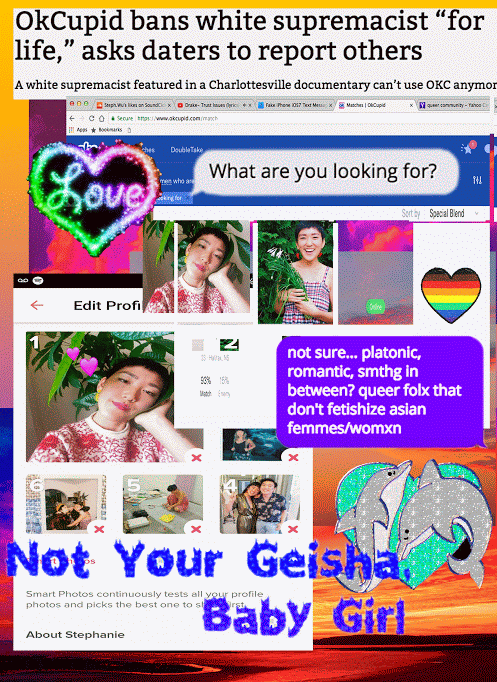
Above and below: Stephanie Wu, digital gif collages for We Met Online: Finding Each Other, exhibited at The Khyber Centre for the Arts, 2017.
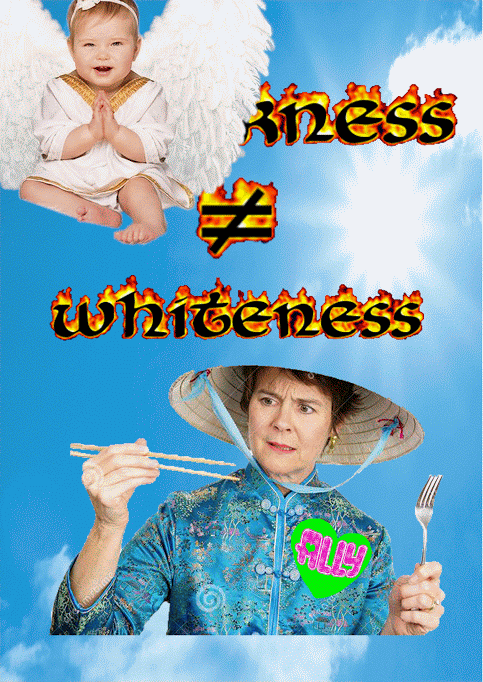
LIZZY HILL: We Met Online: Finding Each Other seems to come from a highly personal place—you speak about the fact that queer people of colour turn to online communities due to their exclusion in queer spaces. How have your own experiences online shaped this body of work?
STEPHANIE WU: I grew up in the suburbs north of Toronto and spent most of my childhood and teenage years in a Chinese Christian church. They made it clear that they were anti queer and trans when they got us to sign petitions against queer rights. It was an unsafe space to question gender and sexuality, so I did it privately and tried to process my own queer identity through the Internet.
“Trauma isn’t white. Mental health isn’t white. For a long time, the Internet felt like the safest space to have conversations about race, gender, sexuality and mental health, when the communities I was brought up in shamed these things.” —STEPHANIE WU
Years later, I turned to online communities in search of visibility of other queer people of colour because the only queer folks I knew were white. I remember having a conversation with a queer, trans person of colour (QTPOC) on Tinder when I was in East Asia and bonding over how difficult it was to find each other when many physical spaces dedicated to queer folks are only accessible to white folks. The whitewashed queer culture in Canada makes it difficult to unlearn internalized homophobia and racism and it’s something that can’t be unlearned separately. Online resources written by QTPOC for other QTPOC have helped me process traumas linked to race and queerness. It made me realize the violence I was experiencing in a previous relationship was rooted in fetishization of Asian femme bodies and colonization.
These online spaces also made me realize that trauma isn’t white. Mental health isn’t white. For a long time, the Internet felt like the safest space to have conversations about race, gender, sexuality and mental health, when the communities I was brought up in shamed these things.
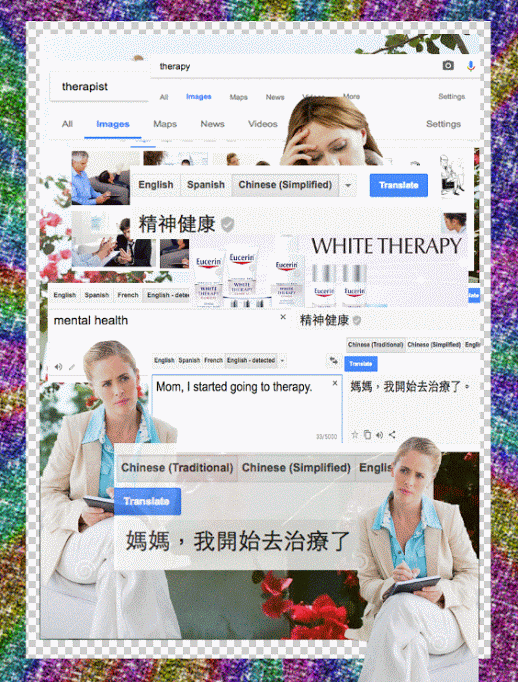
Above and below: Stephanie Wu, Digital gif collages for We Met Online: Finding Each Other, exhibited at The Khyber Centre for the Arts, 2017.
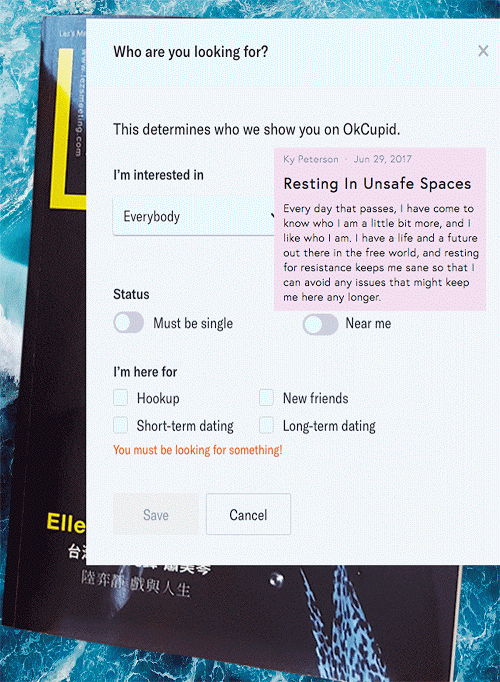
HILL: Full disclosure: I’m a white woman married to a man, with colonial ancestry. Several aspects of your work critique so-called “white allies,” such as your hanging “white ally gloves” in the Khyber installation and your digital gif collage featuring a confused-looking older white lady wielding chopsticks as flames emerge in her eyes. I don’t want to assume I know the answer to this question—How can I be an effective ally? Or is the idea of an ally inherently flawed?
WU: The White Ally Gloves is a critique on white folks that claim they are allies but aren’t willing to do the work. The idea of the gloves is that they can take them off whenever they believe they have contributed enough. They have the choice to not do anything while benefiting off of the systems QTPOCs live in. The Chinese character on the glove says “love” and it comments on white allies using “love” as an excuse to silence the urgency and anger of queer, trans, black, indigenous, people of colour experiences. I believe that allyship plays an important role in dismantling the oppressive structures we live in. But often times, I see white queer folks put “ally” on their dating profile or social media as if it’s a badge of honour. These are some things I believe are important in QTPOC allyship:
- Allyship is active and ongoing;
- Allies need to acknowledge that by staying silent, they are upholding white supremacy;
- Allies need to be self-critical of ways they are privileged and hold power;
- Allies need to use their privilege to leverage those that do not have those privileges;
- Allies need to listen and not be defensive to constructive criticism;
- Allies need to check in with QTPOC and listen to what they need help with instead of doing what they believe is best for them;
- Allies need to amplify the voices of QTPOC instead of speaking over or attempting to represent them;
- Allies need to not take credit for the work of QTPOC;
- Allies need to not demand free labour from QTPOC (you’ve taken enough);
- Allies need to not be doing something in hopes to be thanked and praised by QTPOC communities—And the list goes on…!
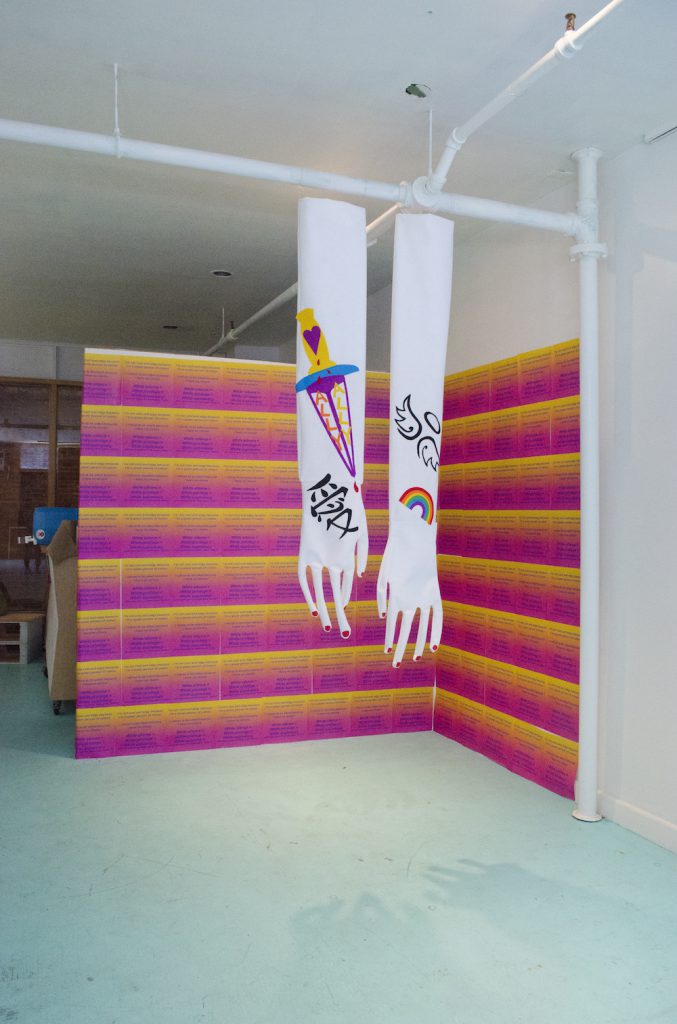
Stephanie Wu, installation view of We Met Online: Finding Each Other, exhibited at The Khyber Centre for the Arts, 2017.
HILL: Part of your Khyber residency residency involved facilitating activities supporting self care and issues relating to mental health—What does self care look like for you and how does it impact your approach to art making?
WU: For me, self care means going back to my communities where I feel grounded. Usually that means being with other queer people of colour and/or celebrating my Chinese roots. Recently, I made dumplings with two other queer Chinese pals and we were figuring out how to fold them. It was refreshing to learn about our roots with others in the queer Asian community.
Self care is extremely important when making work that is so personal and in general to survive everyday life. During the residency, I was spending eight to nine hours a day in the studio, making work about whiteness and it became quite overwhelming. I made sure I scheduled in breaks and spent the weekend outside of the studio. I also made a colouring book filled with affirmations as a gift to the QTPOC community, and because I needed it for myself as well.
HILL: I was struck by your text “I’m not cool and edgy because I’m a queer person of colour” which you repeated on the wall in your Khyber exhibition. The repetition of that text creates a palpable sense of exhaustion. How do you deal with the fact that intersectionality is often conflated with activism in both the art world and everyday life?
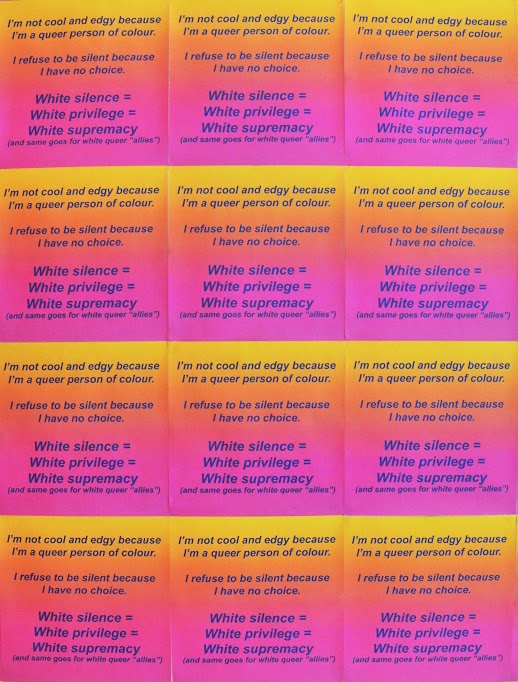
Stephanie Wu, installation detail view of We Met Online: Finding Each Other, exhibited at The Khyber Centre for the Arts, 2017.
“Sometimes I wonder what it would be like to be a white cisgender hetero (cis-het) man in the art world. What would I be making work about? Perhaps my art practice will consist of painting landscapes or taking photos of my friends enjoying Sunday afternoon on a terrace.” —STEPHANIE WU
WU: Sometimes I wonder what it would be like to be a white cisgender hetero (cis-het) man in the art world. What would I be making work about? Perhaps my art practice will consist of painting landscapes or taking photos of my friends enjoying Sunday afternoon on a terrace—I would like to do those things too because… it’s exhausting when simply existing, as a QTPOC, is an act of resistance. When building relationships and communities with other QTPOC are acts of resistance. When loving each other is an act of resistance. When doing simple tasks such as breathing, eating and sleeping are already acts of resistance. Sometimes I don’t want to make work about what I already have to deal with in everyday life. I don’t want to be thinking about whiteness in the studio after being exploited for my work by “white allies” earlier on in the day.
But even though I am a queer person of colour, I hold many privileges and do benefit off of the systems we live in. For example, I have a university degree and am East Asian. I’m also really privileged and grateful to have the time and space to make art and to feel safe enough to speak my mind and stir shit up while knowing I have communities that will hold me.
HILL: Your work playfully, yet powerfully, critiques several contemporary institutions—ranging from our mental health bodies to online dating giants such as OKCupid. Do you think it’s possible to reform existing oppressive spaces or should we rather engage in creating totally new ones?
WU: I believe we can make some changes to spaces that already exist (for example, OKCupid banning white supremacists on their site and AirBnB blocking off housing availability for alt-right gatherings) but ultimately, I do believe that we need to rebuild these institutions from the ground up. Aside from being an artist, I also work in arts and culture institutions. Many of them believe “diversity and inclusion” is a top priority, but a leadership staff workshop on anti-oppression would be too extreme and not needed. I mean, after all, aren’t all Canadians already nice people? Isn’t it impossible to be nice and racist?
“The idea of being ‘inclusive’ is flawed. As a queer person of colour, I don’t want to be ‘included’ and forced into these white colonial structures you’ve built and are upholding.” —STEPHANIE WU
The main focus for many of these organizations is to seem diverse and inclusive to visitors so they can attract communities that aren’t just wealthy white folks. However, there’s not a lot of focus on creating an organization that is equitable internally and externally. That’s because many of those in power, whom are often white cis-het folks, still want to hold onto their power but somehow be diverse and inclusive on the outside. That’s why often times we see advertisements of people of colour representing an organization only to find out that the organization is made up of mainly white people. It’s not unusual to have an organization with a bunch of part-time people of colour staff working the front lines, but those who have offices upstairs and are full time are white staff.
The idea of being “inclusive” is flawed. As a queer person of colour, I don’t want to be “included” and forced into these white colonial structures you’ve built and are upholding. I want you to deconstruct the whole system and build structures that hold space for marginalized communities. We shouldn’t be starting with “diverse and inclusive” programming. We should be looking into who’s on the board, who are the donors, who are the people holding power in the institution, in order to make changes.
HILL: Switching gears, on a purely aesthetic level, your gif collages, for both We Met Online and Digi-land, are so fun to stare at on my phone in the coffee shop I’m writing you these questions from right now. I’m curious to know what your creative process is like? Where do you find your best source material?
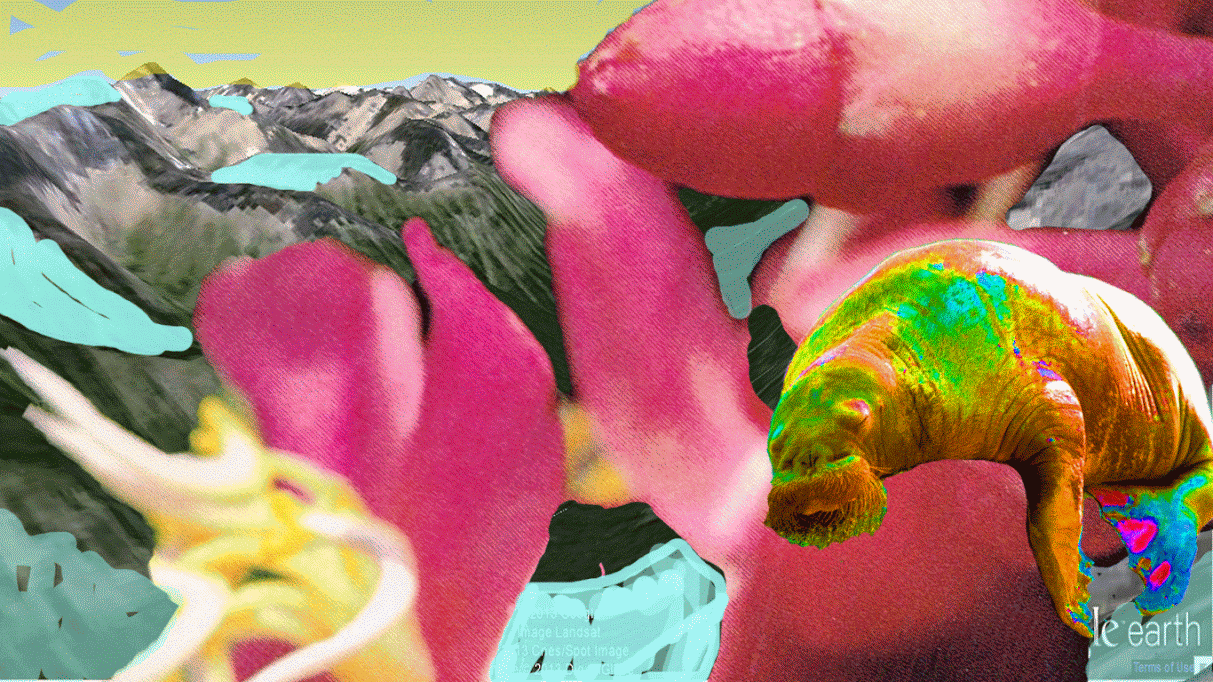
Above and below: Stephanie Wu, digital gif collages for the series @Digi-Land, exhibited in Digiscapes: Nature, Landscapes and Visual Technology in 2014 at Montreal’s Eastern Bloc.
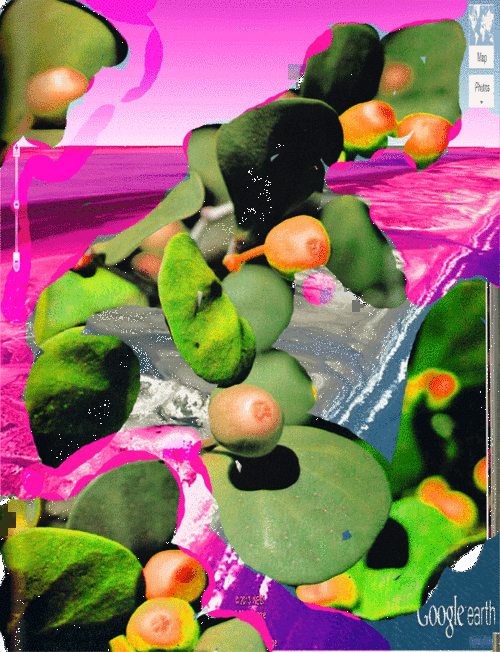
WU: Haha thank you! They make me a bit dizzy sometimes… Digi-Land was the first project I made that involves digital collages, GIFs and projections. Most of the images are scans of old National Geographic magazines I’ve collected in Montreal.
A lot of the images from We Met Online are photos I took on my phone or are screenshots of my own dating profiles and articles I found in QTPOC social media groups I’m in. One of my favourite photos I took is the queer Asian magazine with Ellen DeGeneres on it. I found it at a feminist bookstore in Taipei and felt uncomfortable that they put a white woman on the cover instead of a queer Asian person. My friend translated the words above Ellen’s name and it says social justice warrior on it. It’s definitely an issue I’m noticing in East Asia, where queer Asian communities see Western countries as the epitome of LGBTQ+ activism.
HILL: And before Iet you go—what are you working on recently/exploring creatively?
WU: I’m currently working on a new body of work that overlaps with some of the themes discussed in PROMISED LAND. The working title for this body of work is “Unlearning What I Thought was Love.” The pieces are based on personal childhood and adolescent stories of being raised in a Chinese Christian church in Southern Ontario. Some of the pieces will be based on homophobic/transphobic experiences that took place at church and how those experiences were framed as ‘acts of love’ by the church.


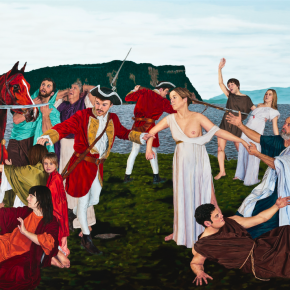













Leave a Reply